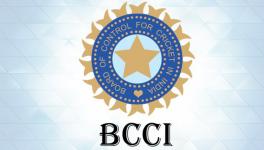As Clear as Night And Day: Pink Ball Tests, Cricket’s Latest Gimmick, a Stopgap Remedy

Ishant Sharma of the Indian cricket team celebrates with teammates after taking a Bangladesh wicket in the Day/Night Test (pink ball Test) at Eden Gardens in Kolkata (Pic: Twitter/BCCI)
The 2019 India vs Bangladesh Test series — comprising of a match in Indore, followed by a two-day gimmick in Kolkata — was sealed by Virat Kohli and his men in emphatic fashion. And make no mistake, that historic day-night Test was a gimmick, no more. While Sanjay Manjrekar may outrage at this non-cricketer scribe branding the historic Pink Ball Test at Eden Gardens in Kolkata a gimmick, the feeling is not exclusive to cricket pariahs. Former players, including a Mr. Michael Holding, think Test cricket can live without the additional bling and floodlit attention from Day/Night matches.
Just to clarify, it has nothing to do with the dislike for the colour pink. It is to do with the fact that day-nighter Tests are not exactly serving the purpose they were designed for — to attract fans towards the five-day format of the game.
Did I just say five days? Sorry! I was under the impression that the day/night Test matches were not five-day affairs. At least that's what the stats show.
Before the historic match at Eden Gardens, which wound up in two days and 45 minutes in favour of India, 12 pink ball Test matches were played. All yielded a winning result, but none lasted the stipulated five days of play. In fact, most barely reach the four-day mark. The novelty factor does attract fans to the stands — as seen in the first ever match at the Adelaide Oval, or even in the two days of play in Kolkata. But, once the colour fades, the ones who thronged the stands to see their cricketing stars play with pink balloons — the target audience of pink Test pushers, the limited-overs cricket fans — will stay away, unwilling to invest emotions and time on 22 men and yards for more than a few hours.
Also Read | The Return of the I-League The Competition Indian Football Thrives On
The original Test aficionados will obviously make the pilgrimage. But, in due course, with matches not lasting enough to give the long format fans their hearfill of the kind of bat and ball contests only Tests could provide, they will lose interest too.
In fact, that is the kind of attrition even red ball Test matches are facing at the moment. Tests across the world over the last five years or so were shorter and resolved quicker than the five days allotted. One of the main reasons is the gulf in quality between the top three teams in the world (the small world of 12 nations that is) and the rest of the Test playing sides. Another reason is clearly the technical and temperamental shortcomings of the players —who grew up on a steady diet of T20 cricket.
Then come the variables the pink ball itself brings in, making the already uneven playing field more lopsided. Cricket, inherently, is not a game that gives both teams the same set of external variables to contend with. There are always factors such as pitch deterioration, dew, weather, wind direction, moisture. You name it, everything has a say in a cricket match. But, in traditional day Test matches, where most of the playing hours were under the sun — barring the opening hours of play — things were more-or-less even as far as ball behaviour is concerned.
Enter the pink ball, and what the players get are conditions that keep changing every hour or so. Some have voiced their concern over spotting the ball, as well as the seam, while most feel the pink ball does more in the air once the sun starts setting. These tricky situations compound the issues for batsmen, who seldom settle down in day/night Tests. And, there we go, a result in two days, and the players get holidays from their hectic schedules.
The loss, in a macro sense, is not just a few days play. The loss is on many counts, from gate revenue for the hosts, to the advertising and air time revenue for the broadcasters, to the daily allowance of the wage labourers and grounds staff. And, last but not least, the loss of quality in Test cricket.
Video | Was India Ever Dreaming of Qualifying for the Qatar World Cup?
The lack of quality was evident in Kolkata, along with a truth that shatters the all-conquering facade Virat Kohli's side walks around with. It needs to be remembered that India refused to play a pink ball Test against Australia while touring Down Under last year. Aussies, with a perfect record in day-night Tests (they have won all five matches played), would have provided a tough initiation for India. And understandably, the normally macho captain developed cold feet. Against a hapless Bangladesh, it took, in the words of the new Board of Control for Cricket in India (BCCI) president, ‘two or three minutes of convincing’ for the game to get scheduled.
Not that the BCCI boss Sourav Ganguly or the Indian cricket team would care for such observations. They are busy celebrating the success, on the field for the players, off it for the administrators.
The first-ever pink ball Test on Indian shores, the history-making moment, was made possible by Ganguly, under whose behest and insistence the match was agreed upon by Bangladesh, despite having no idea what they were getting into.
In the process, Ganguly once again earned 'khoob bhalos' from the Kolkata gentry, who can't thank their dada enough for the historic match. Cricket Association of Bengal (CAB) got a fair share of time under the sun and moon too, and the great Eden Gardens finally got a historic match reminiscent of the old days. These days it is hard to get Tests which create a contest that goes down in the annals of history, redefining greatness. These days we need gimmicks to do the history-making part, and Eden got one.
This gimmick Test could prove harmful for the long format in the long run. The real issues facing the format has nothing to do with the time of day it is played, and everything to do with the way cricket as a sport is losing out in most countries, except India, Australia and England.
Perhaps the International Cricket Council (ICC) could focus on devising means to bring up the level of contest by facilitating development programmes for cash-strapped Boards. Better and evenly contested matches would serve Test cricket better than poor quality, truncated pink ball Tests.
Also Read | FIH, Hockey India Set to Gloss Over Cracks With Another Desi World Cup Spectacle
As far as this series goes, the gimmicks began from the word go — at the start of the tour — with the staging of the T20I at Delhi's Feroz Shah Kotla when the whole of the National Capital Region was choking in smog. The Air Quality Index (AQI) at the time of the match was hovering around 800 (anything above 200 is considered hazardous). It showed how the Ganguly-led BCCI have their priorities vested on the coffers and nothing more.
Ganguly, beyond the smokescreens of these gimmicks, have a lot to clear in the BCCI. His focus has been pretty straightforward, so far. He is planning to amend the cooling off clause for office bearers (a Lodha Panel recommendation). The clause, if in place, would see him vacate the president's post after eight months.
Meanwhile, the Board president is yet to speak publicly about a match fixing scandal that has come to light in the Karnataka Premier League (KPL). It is a serious situation, and one that may provide deja vu for Ganguly.
After all, the new board president was a new skipper when the Indian cricket team was reeling under the Mohammad Azharuddin-Hansie Cronje match fixing scandal. He could distance himself from the controversy then, focusing on captaining the side. But can Ganguly distance himself from the issues this time around? Not entirely. In his new role it is important he outlines plans for the BCCI to weed out the menace of match fixing which seems to have eaten into the various levels of the domestic structure.
One thing is for sure. It won’t happen a pink ball Test at a time.
Get the latest reports & analysis with people's perspective on Protests, movements & deep analytical videos, discussions of the current affairs in your Telegram app. Subscribe to NewsClick's Telegram channel & get Real-Time updates on stories, as they get published on our website.
























